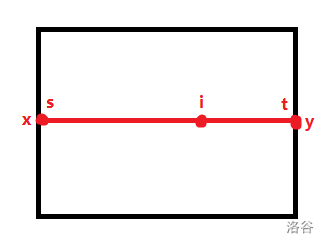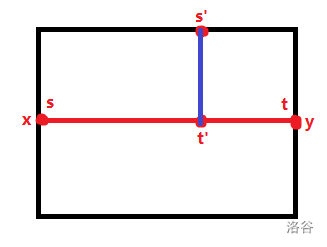AT_joisc2017_j 誘拐 2 (Abduction 2) 题解
对于一个矩形,已知其四边上不考虑其内部道路的所有答案,考虑其中车流指数最大的道路。

如图,红线为矩形中车流指数最大的道路,
两端点 $(k,s),(k,t)$ 不考虑矩形中内部道路的答案分别为 $x,y$,
则 $\forall i\in[s,t]$,可以确定 $(k,i)$ 的答案为 $\max\{x+i-s,y+t-i\}$。
若所询问的点在红线上,则可以返回答案,否则向所询问的点所在的子矩形递归。

设所询问的点在上半个子矩形中。
如图,蓝线为子矩形中车流指数最大的道路,
端点 $(s',k')$ 在黑线上,已知不考虑子矩形中内部道路的答案,
端点 $(t',k')$ 在红线上,不考虑子矩形中内部道路的答案为 $\max\{x+t'-s,y+t-t'\}$。
若所询问的点在蓝线上,则可以返回答案,否则向所询问的点所在的子矩形递归。
特别地,最初整个矩形四边上不考虑其内部道路的所有答案为 $0$。
而且题目中有:
移动开始时,可以任意选择方向。
所以需要考虑开始时的移动方向,递归终止时如果不满足此时枚举的方向需要继续递归。
用 ST 表维护子矩形中车流指数最大的道路。
容易发现最坏情况下最多递归 $H+W$ 层,所以复杂度为 $O(Q(H+W))$。
#include <cstdio>
#include <algorithm>
using namespace std;
struct S
{
int s, t;
long long x, y;
bool v;
} a[50050], b[50050];
int n, m, q, x, y;
long long s;
struct T
{
int n;
pair<int, int> a[20][50050];
void B(int _)
{
n = _;
for (int i = 1; i <= n; ++i)
scanf("%d", &a[0][i].first), a[0][i].second = i;
for (int i = 1; 1 << i <= n; ++i)
for (int j = 1; j + (1 << i) - 1 <= n; ++j)
a[i][j] = max(a[i - 1][j], a[i - 1][j + (1 << i - 1)]);
}
pair<int, int> Q(int x, int y)
{
if (x > y)
return {0, 0};
int k = __lg(y - x + 1);
return max(a[k][x], a[k][y - (1 << k) + 1]);
}
} X, Y;
long long D(int s1, int s2, int t1, int t2, int k1, int k2, int f, int g)
{
auto P = X.Q(s1 + (f >> 0 & 1), t1 - (f >> 1 & 1)),
Q = Y.Q(s2 + (f >> 2 & 1), t2 - (f >> 3 & 1));
int x = P.second, y = Q.second;
if (P > Q)
{
a[x] =
{s2, t2,
b[s2].v ? max(b[s2].x + x - b[s2].s, b[s2].y + b[s2].t - x) : 0,
b[t2].v ? max(b[t2].x + x - b[t2].s, b[t2].y + b[t2].t - x) : 0,
1};
if (k1 == x)
{
if (g == 0)
return D(s1, s2, x, t2, k1, k2, f | 2, g);
if (g == 1)
return D(x, s2, t1, t2, k1, k2, f | 1, g);
if (g == 2)
return a[x].x + k2 - s2;
if (g == 3)
return a[x].y + t2 - k2;
}
if (k1 > x)
return D(x, s2, t1, t2, k1, k2, f | 1, g);
if (k1 < x)
return D(s1, s2, x, t2, k1, k2, f | 2, g);
}
if (P < Q)
{
b[y] =
{s1, t1,
a[s1].v ? max(a[s1].x + y - a[s1].s, a[s1].y + a[s1].t - y) : 0,
a[t1].v ? max(a[t1].x + y - a[t1].s, a[t1].y + a[t1].t - y) : 0,
1};
if (k2 == y)
{
if (g == 0)
return b[y].x + k1 - s1;
if (g == 1)
return b[y].y + t1 - k1;
if (g == 2)
return D(s1, s2, t1, y, k1, k2, f | 8, g);
if (g == 3)
return D(s1, y, t1, t2, k1, k2, f | 4, g);
}
if (k2 > y)
return D(s1, y, t1, t2, k1, k2, f | 4, g);
if (k2 < y)
return D(s1, s2, t1, y, k1, k2, f | 8, g);
}
}
void F(int x, int y, int g)
{
for (int i = 1; i <= n; ++i)
a[i].v = 0;
for (int i = 1; i <= m; ++i)
b[i].v = 0;
s = max(s, D(1, 1, n, m, x, y, 0, g));
}
signed main()
{
scanf("%d%d%d", &n, &m, &q);
X.B(n);
Y.B(m);
while (q--)
{
scanf("%d%d", &x, &y);
s = 0;
if (x != 1)
F(x, y, 0);
if (x != n)
F(x, y, 1);
if (y != 1)
F(x, y, 2);
if (y != m)
F(x, y, 3);
printf("%lld\n", s);
}
return 0;
}



 浙公网安备 33010602011771号
浙公网安备 33010602011771号